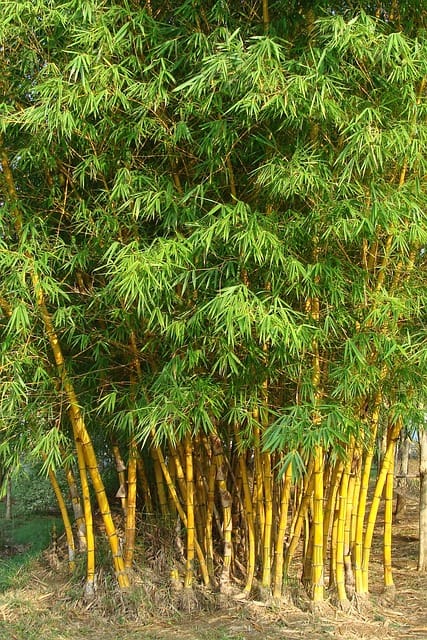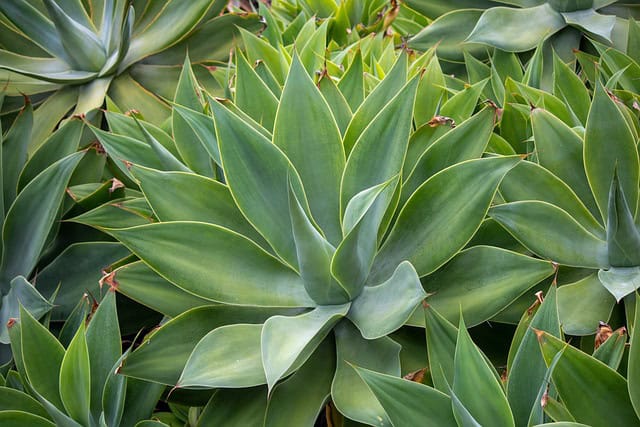In this post, we’ll explore how to successfully grow hardy tropical plants, highlight stunning flowering options, and recommend suitable trees that bring a taste of the tropics to your landscape.
How To Grow Hardy Tropical Plants In Zone 7
When contemplating a tropical garden in Zone 7, the first step involves understanding the environment. While winters can bring temperatures as low as 0°F to 10°F (-18°C to -12°C), many plants maintain their beauty despite these conditions through adaptability or specific planting techniques.
To maximize the success of tropical plants in this zone, consider the following strategies:
Microclimates: Utilize microclimates in your landscape by planting in areas that offer protection from harsh winds and cold temperatures. South-facing walls or regions surrounded by buildings can trap heat and provide a more favorable environment for growth.
Soil Preparation: Tropical plants often prefer well-draining, nutrient-rich soil. Enhance your garden bed with organic matter such as compost or peat moss to improve drainage and fertility.
Mulching: Implement a thick layer of mulch as winter approaches. This will help insulate the soil, reducing temperature fluctuations and protecting plant roots during cold spells. In spring, removing the mulch is advisable to encourage warmth and growth.
Container Gardening: For particularly sensitive tropical specimens, consider potting them. This allows you to move the plants indoors or to a sheltered location during winter, minimizing the risk of frost damage.
Selection of Hardy Varieties: Focus on plants specifically bred or known for their hardiness in cooler climates. Research is crucial for finding varieties that will thrive without losing their tropical aesthetic.
Through these measures, you can successfully cultivate a rich tapestry of colors, textures, and forms that evoke the feel of a tropical paradise.
Flowers For Zone 7
Incorporating flowering plants into your tropical garden can offer brilliant color and seasonal interest. Here are three stunning options for Zone 7 gardens that exhibit a certain tropical flair:
Hibiscus

Hibiscus plants are often the stars of any tropical landscape due to their large and vibrant flowers. The perennial varieties, such as Hibiscus moscheutos, or the hardy swamp hibiscus, boast blooms that can reach up to 12 inches in diameter. They thrive in full sun and prefer moist, well-draining soil. These stunning perennials can be planted in garden beds or used as focal points in mixed borders. Their eye-catching blooms typically flower from mid-summer into early fall, ensuring that your garden remains colorful even as other plants prepare for dormancy.
Maypop (Passionflower)

The Maypop or Passionflower (Passiflora incarnata) is a resilient, fast-growing vine that displays unique, intricate flowers reminiscent of tropical design. Adaptable to almost any well-drained soil, this vine is drought-tolerant once established. The passionflower’s striking purple blooms draw pollinators and can develop into orange-yellow fruits that are both edible and nutritious. Not only does it add vertical interest to the garden, but its lush foliage helps recreate a tropical atmosphere.
Azalea

While azaleas are commonly associated with traditional temperate gardens, certain varieties offer a subtropical feel that complements a tropical theme. The Evergreen Azaleas bring colorful blooms in shades of pink, red, and white, often blooming in late spring. They thrive under partial shade, making them perfect for garden beds. Their evergreen foliage maintains visual interest throughout the year, and when selected carefully, they can harmonize beautifully with more overtly tropical plants in your garden.
Trees Suited To Zone 7
Trees can serve as the backbone to your tropical-looking garden, providing height, shade, and structure. Here are four trees that flourish in Zone 7 and embody a tropical appeal:
Crape Myrtle

The Crape Myrtle (Lagerstroemia indica) is celebrated for its stunning summer blooms and smooth, peeling bark. These trees can be pruned to maintain a bushy look or grow taller depending on the cultivar. Their long-lasting flowers range in color from white to pink to purple, creating a vibrant display throughout the hot months. Crape myrtles are known for their resistance to drought once established and can thrive in various soil types, making them excellent foundation trees or focal points in a tropical garden.
Fig Tree

The Fig Tree (Ficus carica) is a delightful addition for those seeking an edible touch in their tropical garden. With its lush, large lobed leaves, it exudes a tropical aesthetic, and the fruits are sweet and nutritious. In Zone 7, the fig tree requires a sunny location with well-draining soil to flourish. Varieties like ‘Brown Turkey’ and ‘Celeste’ are particularly hardy and can withstand the winter chill if properly cared for. A fig tree not only provides delicious fruit but also serves as an eye-catching centerpiece due to its broader foliage, which contributes to the tropical look of the garden landscape.
Palm Tree

While many palm species thrive in warmer climates, certain varieties can withstand the conditions of Zone 7. The Windmill Palm (Trachycarpus fortunei) is a popular choice due to its cold tolerance and distinctive fan-shaped leaves. With proper care, it can grow into a stunning feature in your landscape. Planting it in a sheltered area helps protect it from frost. The striking trunk and lush fronds create an unmistakably tropical ambiance and can be complemented with other exotic plants.
Banana Tree

The Tropical Banana Tree (Musa spp.), while technically a herbaceous plant, provides an unmistakably tropical vibe with its large, lush leaves and impressive height. Varieties like the Hardy Banana (Musa basjoo) can survive in Zone 7 with some care. Banana trees prefer rich, well-draining soil and full sun for optimal growth. To ensure they endure winter, it’s essential to provide winter protection by cutting them back and mulching the base heavily or wrapping the stems for insulation. The dramatic foliage of banana trees not only enhances the tropical theme but also creates an interesting architectural element in your garden design.
Lush Greenery For Zone 7
When considering greenery that provides a rich, tropical ambiance, specific plants stand out for their striking foliage and overall resilience. Below are some excellent choices for Zone 7:
Alocasia (Elephant Ear)

The Alocasia, commonly referred to as Elephant Ear, is known for its large, dramatic leaves that can reach impressive sizes. These plants thrive in areas with partial shade and need well-drained, nutrient-rich soil. Alocasias are not only visually astounding, but they also bring a tropical flare to your garden. Varieties like Alocasia ‘Amazonica’ or Alocasia macrorrhiza add boldness with their sculptural foliage and can be used effectively as focal points or in patio containers. While Alocasia can be sensitive to frost, they can be grown as annuals in cooler areas or moved indoors during the winter months.
Colocasia (Elephant Ear)

Similar in appearance and appeal to Alocasia, Colocasia, or Taro, also features large, heart-shaped leaves that can create a lush, jungle-like atmosphere. These plants prefer wetter conditions and are commonly found in bogs or along pond edges. They flourish in full sun to partial shade and can produce small edible tubers, making them both beautiful and practical. The captivating foliage of Colocasia varieties, such as Colocasia esculenta, creates an impressive visual impact, especially when planted in groups to enhance their presence in garden beds or borders.
Gunnera (Giant Rhubarb)

For gardeners seeking truly unique foliage, the Gunnera (often referred to as Giant Rhubarb) is a must-try. This frost-hardy perennial features massive, umbrella-like leaves that can span up to 3 feet across. Gunnera thrives in moist, fertile soils and prefers partial to full sunlight. It can grow quite large, providing a dramatic touch to your garden. This plant enjoys a humid environment, making it ideal for planting near water features or in shaded, moist areas where its large leaves can absorb moisture easily. Gunnera is an excellent choice for creating a striking focal point and can make any garden feel more exotic.
Ferns

Ferns are among the most versatile plants that can thrive in Zone 7. Their feathery fronds create a lovely textural contrast against broader-leaved plants, enhancing the exotic feel of a tropical garden. There are numerous species of ferns suitable for various light conditions, including the Japanese Painted Fern (Athyrium niponicum), which boasts beautiful variegated leaves, and the Ostrich Fern (Matteuccia struthiopteris), known for its lush, arching fronds. Ferns thrive in well-drained, rich soil and prefer shaded areas, making them ideal for woodland gardens or under the canopy of taller plants. They provide greenery throughout the growing season and maintain their aesthetic appeal well into autumn.
Sugar Cane

Sugar Cane (Saccharum officinarum) is not only a beautiful plant but also a unique addition to your Zone 7 garden. This tall grass can grow between 6 and 12 feet tall, offering a stunning vertical element. While it needs a warm and sunny location to thrive, it can adapt well in fertile, well-draining soil. Sugar cane is often utilized in gardens for its ornamental value due to its tall stalks and lush foliage, and it is a quick-growing plant that can add tropical vibes throughout the summer months. Although it is not frost-tolerant, it can be grown as an annual or harvested and protected over the winter to plant again the following spring.
Bamboo

Bamboo is an excellent choice for adding a lush, tropical feel to gardens in Zone 7. There are many varieties of hardy bamboo that can thrive in this zone, such as Fargesia, which is a clumping type that does not spread aggressively. Bamboo thrives in well-draining soil and prefers full sun to partial shade. The graceful canes and leaves create a stunning visual and can be particularly effective for privacy screens or as hedges. Additionally, bamboo’s rapid growth and ability to provide sound dampening make it a favored choice for serene, garden landscapes.
Sumptuous Succulents
In addition to lush greenery, succulents can offer a charming contrast with their unique shapes and low maintenance requirements. Though typically associated with dryer climates, several succulent varieties can thrive in Zone 7, providing an interesting layering of plants in your garden.
Yucca

Yucca plants are known for their striking architectural appearance and succulent leaves. These drought-tolerant perennials feature sword-shaped leaves that add a dramatic touch to any garden. Yucca thrives in full sun and well-drained soil, making it an excellent choice for dry, sandy areas or rock gardens. The plant blooms in summer, producing tall spikes filled with large, creamy white flowers that attract pollinators, including hummingbirds. Varieties such as Yucca filamentosa are particularly hardy and can withstand brief periods of cold, making them a perfect sub-tropical accent in your Zone 7 garden.
Agave

Agave is another captivating succulent that offers a distinct, architectural quality to garden spaces. Known for their rosette shape and thick, fleshy leaves, agaves are primarily drought-tolerant and prefer well-drained soil. In Zone 7, Agave americana or Century Plant can be an exciting choice, as it can survive in less protected areas. Agaves produce stunning flower spikes that can reach heights of 10 feet or more, offering a dramatic display when blooming. Though they are primarily found in southwestern landscapes, they can certainly adapt to the conditions of Zone 7 with proper positioning and care, allowing gardeners to enjoy their striking appearance and low maintenance needs.
Opuntia

Opuntia, commonly known as prickly pear cactus, is a visually intriguing and hardy succulent variety perfect for gardens in Zone 7. This plant is not only suitable for xeriscaping but also provides vibrant yellow or pink flowers in the summer, followed by colorful edible fruits known as “tuna.” Opuntia species such as Opuntia humifusa are native to North America and adapted to a range of soil types, although they thrive in well-drained conditions. These cacti add a unique flair and serve as conversation starters in gardens, giving an exotic touch while requiring minimal water and care.





